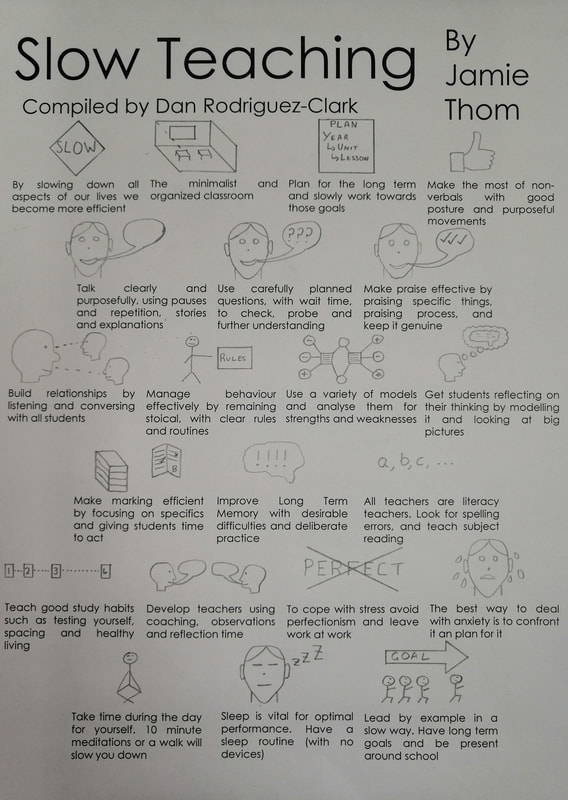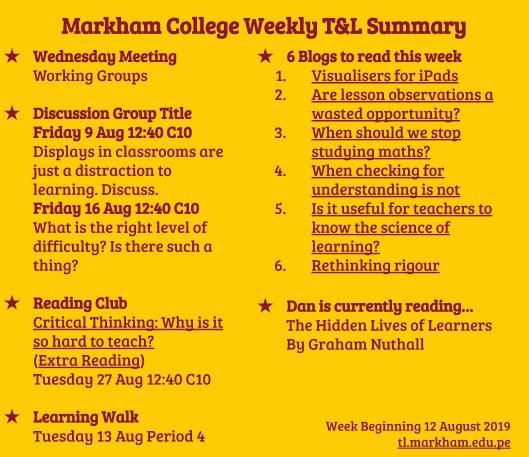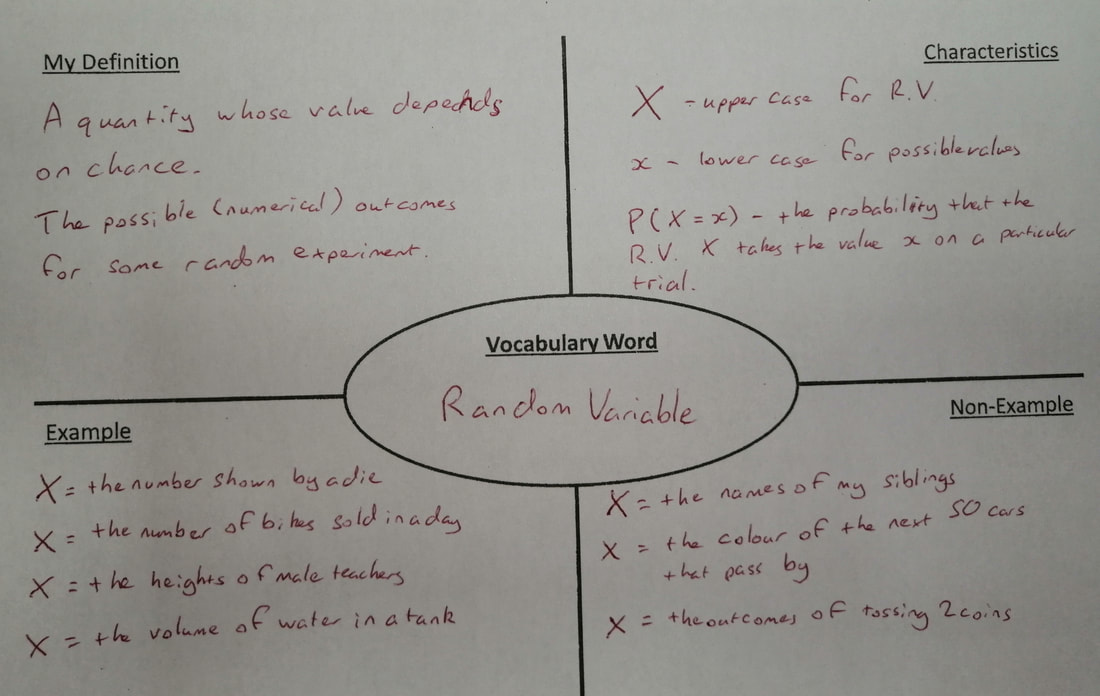- Is your classroom in need of a minimalist review?
- What immediate changes could you make to ensure the clarity and organisation of your environment?
- What would the impact of ten minutes of decluttering a day have on your psychological state?
- What new organisational structures could you implement?
- Does you classroom model student excellence?
- Is the passion you have for your subject clear in your classroom?
- Are you falling into the Mr Hare planning trap?
- Do you have a clear vision of where each class you teach needs to be by the end of the term and by the end of the year?
- Have you broken down the learning into manageable chunks of planning?
- Do you have a clear idea of what each assessment will be for schemes of work?
- Have you slowly mastered the content you will be teaching?
- Have you considered student misconceptions in your planning?
- Have you planned for slow and deliberate practice in individual lessons?
- Are you regularly checking students' understanding?
- Do you spend time reflecting on your non-verbal communications in the classroom?
- Are you conscious of your posture and the impact it has?
- Could you embrace a straighter, more upright posture?
- Do you use had gestures purposefully to support your words?
- Do you have teacher blind spots in the classroom; are you engaging with the whole room through eye contact?
- How could you use eye contact more effectively to build positive relationships
- Could you move more strategically in your classroom?
- Could your teacher talk be deliberately slowed down?
- Are you aware of you breathing in the classroom and how this is impacting your ability to explain?
- Could you embrace elements of Churchillian preparation of your teacher talk?
- Are you aware of how students are responding to the pace of your speech?
- What could you do to employ the pause more effectively in the classroom?
- Are you harnessing the power of slow storytelling and anecdotes in the classroom?
- Are you falling into the 'rapid-rifle approach' to questioning?
- What other questioning traps do you need to be conscious of in your teaching?
- What 'wait time' strategies could you easily implement into your own teaching?
- Are you getting the balance right between closed and open questions?
- Could you make more use of questioning as a form of differentiation in your lessons?
- How could you script your questions for impact?
- What strategies can you use to tackle the "don't know' or quiet classes?
- Are you falling into over-praising with any of your students or groups?
- What phrases could you adapt to make your praise more specific?
- Is their scope in your classroom to make praise more related to effort?
- Are you striving to encourage a growth mindset in your classroom?
- Are you looking for classroom 'bright spots' and praising students who demonstrate behaviour expectations?
- How often are you positively engaging with parents?
- Do you celebrate the commitment and support of teachers who work alongside you?
- Are you making enough time outside of your busy teaching day to prioritise building positive relationships?
- Is the empathetic mindset present in your interactions with young people?
- Are you communicating genuine enthusiasm in the presence of all your students?
- How well are you listening to students both inside and outside of the classroom?
- Are you conscious of the introvert/extrovert divide and using strategies to positively engage with both?
- Could you involve yourself in more activities outside of the classroom to generate positive relationships with students?
- Do you focus on what you can proactively control when reflecting on behaviour?
- Are you self-aware and able to moderate emotion when working with challenging classes?
- Is there consistency and calm at the heart of your classroom persona?
- Are you applying whole-school behaviour policies rigorously in your work at school?
- Are the behaviour essentials imbedded in your work with each of your classes?
- What other aspects of stoical philosophy could you apply to your teaching?
- Is you marking revealing significant misconceptions students have about how to structure and approach tasks?
- Are you investing lesson time in sharing assessment criteria that is difficult for students to grasp?
- What role does modelling play in your classroom now and could it be employed more?
- Are you making your thinking explicit to students and deconstructing how to approach a task?
- Could the be more scope for you to prepare a teacher model answer?
- Are you confident about not marking work and instead providing students with a model to ensure clarity about how they should complete a task?
- What opportunities are there to use student model answers in your lessons?
- Are you reflecting on ways to improve your students' ability to consider their own thinking?
- Are there more opportunities in lessons to model your thinking about how to approach tasks with students?
- Is time designated in lessons to give students opportunities to plan out how they will approach a task? Are they aware of the strategies that can use to do this?
- What steps are you taking to ensure that students are pausing and considering how well they are completing tasks?
- Is there time at the end of each task for students to evaluate how well it has been completed and make changes?
- Are you exploring both resilience and motivation with your students and making it a real focus in your interactions with them?
- Are you becoming another victim of mindless marking fervour?
- Is there a more strategic approach you could take in deciding what to mark and when?
- Are you emphasising the sacred nature of marking and giving students time to construct a detailed self-assessment?
- Is your written feedback to students sparse and instructional?
- How much effort is going into training your students on how to respond to feedback?
- Could you look at building in more structured examples of peer assessment?
- Are you considering memory in your planning and teaching on a daily basis?
- Are there more opportunities to employ the power of testing in your lessons?
- Are you falling into the 'speedy content' trap, racing through without returning to check understanding and interleave content?
- Are you allowing time for deliberate repetition of skills and giving students plenty of opportunities to practice?
- What potential is there for streamlining your lessons to provide complete clarity for your students?
- Are you being reflective about cognitive overload in your lessons?
- What potential could mnemonics have to aid students' memories in you subject?
- Do you know the literacy demands of your individual subject(s)?
- How much and how often do you ask students to read in your subjects?
- Do you coach students on how to approach the style of reading required?
- How often do you model and discuss your own reading habits with students?
- Are you driving forward reading with your students, encouraging and providing them with guidance on reading for pleasure?
- Do you make spelling a focus in your lessons?
- Do you deconstruct spelling and use a range of strategies?
- Are you literacy aware in your marking? Do you mark for grammar and spelling alongside content? Do you encourage students to proofread with a literacy lens?
- Are your students suffering from a lack of clarity about how to revise?
- Are you tackling the symptoms of over-confident students?
- Are your students clear on the dangers of cramming?
- What are the procrastination avoidance tips you can arm your students with?
- Can you help students to construct a revision timetable?
- What self-testing techniques do you want students to employ in their revision?
- What aspect of your teaching would you value more feedback on?
- Who have your observed recently that has influenced an aspect of your teaching?
- Who has observed you teach and what was the impact of their observation?
- Could you designate more time to reflecting on your impact in the classroom? How would you complete this reflection?
- What dialogue are you regularly sharing about teaching?
- Could you act in a coaching capacity for a colleague? Would you benefit from some coaching?
- Could you engage more in research about teaching?
- Are you at risk of burnout?
- What is your relationship like with stress?
- What strategies are you using to manage feelings of stress?
- Are you using the support network of colleagues in school?
- Are you conscious of the perfectionism trap?
- Could you build in more optimism into both your internal and external presence in school?
- Do you have a clear grasp of the potential anxiety trigger points in the year?
- Have you got an action plan for the first two weeks of the new academic year?
- Are you using a checklist approach to planning your day and week?
- Are you planning for parental meetings to help feel calm and be prepared?
- Is collaboration high up on your agenda?
- How can you ensure calm clarity during the exam season?
- Are you confidently informed and ready for an Ofsted inspection?
- What is your relationship with sleep like? Are you getting enough?
- Do you have a sleeping routine that you are sticking to?
- Could you reduce your caffeine intake?
- Is you bedroom a haven for sleep?
- Do you need to curb your use of electronic devices?
- Could you make time for more exercise to improve your wellbeing and sleep?
- Are you addressing worries proactively before going to sleep?
- How much of your day is spent on autopilot; present in body but not mind?
- Could you put ten minutes aside for yourself a day?
- What meditating routine would work best for you?
- How else could you use mindfulness throughout the day?
- Could you make time for some mindful eating or walking?
- Are you clear about your motivation for teaching and learning?
- Are you a visible leader in school? How do you measure your impact?
- What values are important to you?
- How are you demonstrating those values?
- What policy processes could be streamlined to help staff?
- Is wellbeing a conversation your school is having?
- What are you doing to continue learning an developing?



 RSS Feed
RSS Feed
